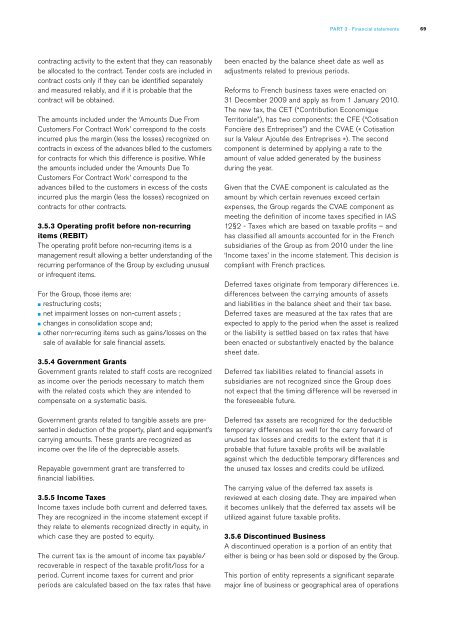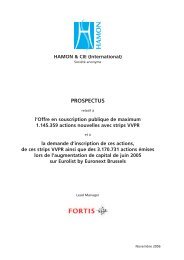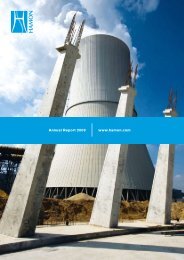Download PDF version English (3237KB) - Hamon
Download PDF version English (3237KB) - Hamon
Download PDF version English (3237KB) - Hamon
You also want an ePaper? Increase the reach of your titles
YUMPU automatically turns print PDFs into web optimized ePapers that Google loves.
Part 3 - Financial statements<br />
69<br />
contracting activity to the extent that they can reasonably<br />
be allocated to the contract. Tender costs are included in<br />
contract costs only if they can be identified separately<br />
and measured reliably, and if it is probable that the<br />
contract will be obtained.<br />
The amounts included under the ‘Amounts Due From<br />
Customers For Contract Work’ correspond to the costs<br />
incurred plus the margin (less the losses) recognized on<br />
contracts in excess of the advances billed to the customers<br />
for contracts for which this difference is positive. While<br />
the amounts included under the ‘Amounts Due To<br />
Customers For Contract Work’ correspond to the<br />
advances billed to the customers in excess of the costs<br />
incurred plus the margin (less the losses) recognized on<br />
contracts for other contracts.<br />
3.5.3 Operating profit before non-recurring<br />
items (REBIT)<br />
The operating profit before non-recurring items is a<br />
management result allowing a better understanding of the<br />
recurring performance of the Group by excluding unusual<br />
or infrequent items.<br />
For the Group, those items are:<br />
■ restructuring costs;<br />
■ net impairment losses on non-current assets ;<br />
■ changes in consolidation scope and;<br />
■ other non-recurring items such as gains/losses on the<br />
sale of available for sale financial assets.<br />
3.5.4 Government Grants<br />
Government grants related to staff costs are recognized<br />
as income over the periods necessary to match them<br />
with the related costs which they are intended to<br />
compensate on a systematic basis.<br />
Government grants related to tangible assets are presented<br />
in deduction of the property, plant and equipment’s<br />
carrying amounts. These grants are recognized as<br />
income over the life of the depreciable assets.<br />
Repayable government grant are transferred to<br />
financial liabilities.<br />
3.5.5 Income Taxes<br />
Income taxes include both current and deferred taxes.<br />
They are recognized in the income statement except if<br />
they relate to elements recognized directly in equity, in<br />
which case they are posted to equity.<br />
The current tax is the amount of income tax payable/<br />
recoverable in respect of the taxable profit/loss for a<br />
period. Current income taxes for current and prior<br />
periods are calculated based on the tax rates that have<br />
been enacted by the balance sheet date as well as<br />
adjustments related to previous periods.<br />
Reforms to French business taxes were enacted on<br />
31 December 2009 and apply as from 1 January 2010.<br />
The new tax, the CET (“Contribution Economique<br />
Territoriale”), has two components: the CFE (“Cotisation<br />
Foncière des Entreprises”) and the CVAE (« Cotisation<br />
sur la Valeur Ajoutée des Entreprises »). The second<br />
component is determined by applying a rate to the<br />
amount of value added generated by the business<br />
during the year.<br />
Given that the CVAE component is calculated as the<br />
amount by which certain revenues exceed certain<br />
expenses, the Group regards the CVAE component as<br />
meeting the definition of income taxes specified in IAS<br />
12§2 - Taxes which are based on taxable profits – and<br />
has classified all amounts accounted for in the French<br />
subsidiaries of the Group as from 2010 under the line<br />
‘Income taxes’ in the income statement. This decision is<br />
compliant with French practices.<br />
Deferred taxes originate from temporary differences i.e.<br />
differences between the carrying amounts of assets<br />
and liabilities in the balance sheet and their tax base.<br />
Deferred taxes are measured at the tax rates that are<br />
expected to apply to the period when the asset is realized<br />
or the liability is settled based on tax rates that have<br />
been enacted or substantively enacted by the balance<br />
sheet date.<br />
Deferred tax liabilities related to financial assets in<br />
subsidiaries are not recognized since the Group does<br />
not expect that the timing difference will be reversed in<br />
the foreseeable future.<br />
Deferred tax assets are recognized for the deductible<br />
temporary differences as well for the carry forward of<br />
unused tax losses and credits to the extent that it is<br />
probable that future taxable profits will be available<br />
against which the deductible temporary differences and<br />
the unused tax losses and credits could be utilized.<br />
The carrying value of the deferred tax assets is<br />
reviewed at each closing date. They are impaired when<br />
it becomes unlikely that the deferred tax assets will be<br />
utilized against future taxable profits.<br />
3.5.6 Discontinued Business<br />
A discontinued operation is a portion of an entity that<br />
either is being or has been sold or disposed by the Group.<br />
This portion of entity represents a significant separate<br />
major line of business or geographical area of operations














